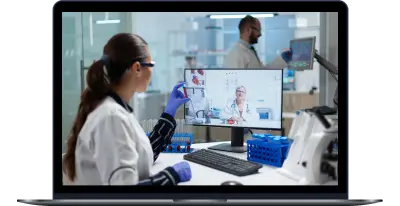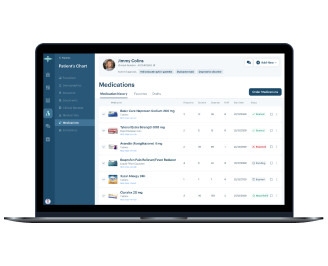IoT-enhanced telehealth platform
Discover how we implemented new IoT and remote patient monitoring functionality for a telehealth platform to improve patient–doctor communication and overall patient care.
-
industry
Healthcare
-
Country
USA
-
Team size
20+ specialists
-
Period of collaboration
2021–2022
About the client
Our client is a US-based technology company that provides hospitals and clinics with smart customizable healthcare software. The company saw an opportunity to use IoT devices in telemedicine to help clinicians more efficiently and effectively treat remote patients.
Prior to this project, Yalantis developed customizable modules for the client — specifically, a hospital administration module, a patient portal module, and an extendable electronic health record (EHR) module.

Business context
To help our client achieve their business goals, we had to meet the following objectives during the project execution:
- Address a lack of vital patient data by integrating with medical IoT devices to enable extensive analysis of patient health conditions
- Provide clinicians with comprehensive health backgrounds for remote patients to enable a more tailored treatment approach
- Ensure the possibility of monitoring patients in rural areas
- Enhance a clinician-facing app and patient-facing app with critical functionality that meets the client’s core objectives
Solution overview
-
Implementing a remote patient monitoring module and integrating with medical IoT devices as well as addressing arising challenges required enhancements throughout the whole platform that the Yalantis team successfully provided.
Integrating IoT devices to enhance patient–clinician interactions
At our client’s request, we worked on collecting two categories of data. The first type is clinical data that included EKG-gathered parameters, blood pressure, and oxygen saturation. Our client started partnering with an IoT medical device vendor, allowing us to use modern BLE-enabled medical devices and the provider’s SDK for direct data gathering. We managed to easily configure devices such as Bluetooth EKG monitors, Bluetooth blood pressure monitors, and Bluetooth pulse oximeters. Another data type is fitness data, which included physical activity (number of steps and pulse over time) and historical heart rate data. This data allows doctors to determine a patient’s condition during daily activities and under regular physical load. To enable patients to use their own wearables, we ensured smooth integration with the most popular and widely used models.
Optimizing IoT data flows
Wearables regularly send terabytes of disorderly data to the client’s system, complicating data analysis. To make this integration truly beneficial for doctors, we needed to optimize the data flow and sort data according to medical requirements. To enable a seamless IoT data flow, we created a schedule-based data control mechanism that collects device data from the provider’s cloud storage, processes it, and summarizes it. We also provided clinicians with direct access to patients’ vitals received from wearables via the EHR system.
-
Ensuring cost-effective data storage
We used a data compression method to manage data older than three months from various types of devices. After compression, data is archived. Data that is more than a year old is transformed into overviews of specific periods. Additionally, after the system generates weekly summaries based on daily information, it deletes the daily measurements. Plus, all stored data is subject to time limits. The system discards data that is no longer valid based on criteria established by physicians for the sake of preserving resources and ensuring smooth system operation.
Implementing security measures
Data is transferred from patients’ mobile applications to the EHR system in compliance with HL7 security requirements. Patients receive a patient onboarding box containing personal medical devices and instructions for using the patient-facing web and mobile applications. By using a unique patient number when pairing a device with the patient app, patients let the system recognize medical devices and assign them to individuals. We also designed a remote patient monitoring module with in-depth explanations on the use of healthcare data so that patients understand exactly what they are consenting to.
-
Modernizing EHR system
We optimized fitness data collection. Data from wearables goes through the preprocessing stage and is delivered to the EHR system in the right format. Our team used Bluetooth technology to smoothly transfer data from personal medical devices to the IoT-based application. After device onboarding is completed, the system keeps data on a device’s carrier, size, serial number, and condition in the internal catalog, allowing clinicians to manage patients’ devices.
Improving patient-facing application
Patients can now take and send measurements during an online session with a physician. To improve the quality of therapy and monitoring, we created a routine scheduling tool for doctors to assign medication schedules and check vital signs. Patients receive notifications so they don’t miss these activities. Patients now also have access to a dashboard with average statistics regarding their health right in the application. We adjusted the patient app interface by adding new user flows so patients can easily send their data, follow preset regimens, and track their progress at every age and with any health condition.
Enhancing clinician-facing app
Clinicians can use a basic rule-builder and an exercise template library to develop customized commands and prescribe routines based on patients’ conditions. We introduced reports, reviews, and graphs to make it easier for doctors to evaluate large patient data sets. The IoT platform now allows parties to exchange fresh data during a consultation and then continue the consultation without interruption. The application also sends push notifications to physicians when a patient’s vitals have been consistently decreasing or suddenly decrease.
Value delivered
Thanks to this project, our client has increased their market share and is proceeding with their digital transformation journey. They also decided to go through the ONC Health IT Certification Program with guidance from Yalantis experts. Now, the upgraded telemedicine solution demonstrates that it meets requirements in terms of technological capabilities, functionality, and security.
After the integration with medical IoT devices, patients can now:
-
Use medical devices at home to track their health and share information with their doctors
-
Receive notifications about prescribed exercises as well as measurement and medication routines
-
Send vitals to a doctor during an online session
Doctors can now:
-
Receive real-time patient vitals during an online session
-
Make in-depth examinations with more patient data
-
Schedule patients’ exercise, medical exams, and medication routines
-
Receive alerts and warnings if a patient’s condition worsens
-
Monitor the condition of patients’ medical devices
Increase your market share with new functionality
Enrich your healthcare systems with additional functional modules, help your healthcare practice achieve new business goals, and adapt to the new market reality.


